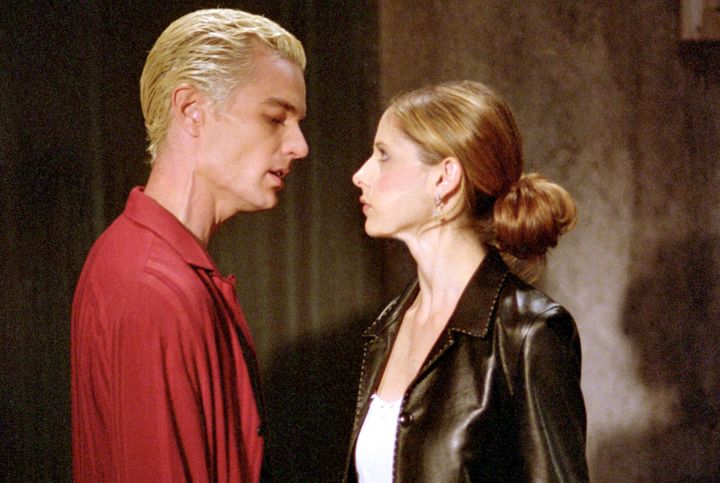
In an oft-quoted line from “Buffy the Vampire Slayer,” the titular slayer herself quips: “Dawn’s in trouble, must be Tuesday.” The line, delivered after learning that her younger sister is in trouble in the musical episode in Season 6, is a meta reference to the night that Buffy used to air on television.
Buffy’s bit of banter has been referenced by other shows as well, including “Supernatural” and “The Flash.”
The moment is more than just a wink-and-a-nudge to the show’s time slot, concocted in a boardroom by a bunch of executives. It was a very real ode to the time fans carved out every week, choosing to spend it with Buffy, rather than with other characters jostling for their attention. Watching her story unfold was an intentional journey, like a great, long friendship. To watch “Buffy” every week was akin to Carrie going to brunch with Samantha.
There are still multiple television shows that continue to release on set days of the week, but in the binge-watching era, shows are less tied to temporality than they were in the past. If your favorite show releases on Tuesday evenings on Netflix or Max but you can’t catch it, you can simply watch it the next day — or more likely, months later, when all the episodes are available and you can lie down and consume them all in one go. In this sense, binge-watching has turned the temporality of TV on its head: Those of us who grew up prior to the streaming era would conform our schedules around television shows, now television shows are available to us when our schedule permits.
Part of the joy of what was called “appointment TV” was that its time was considered a feature, not a bug of the format. When we talk about “watercooler moments” on television — or things that you could discuss the next day around the office — we are referencing the way that TV brought people together in communities based on the day and time it aired. Sure, you can have a community when something drops — but that level of camaraderie and community is no longer a formal part of the television viewing experience.
When audiences would check in with Buffy and the Scooby Gang, we could spout theories, we could process the events, we could make predictions. Bingeing, much like the type of eating it describes, is often something done in solitude, cut off from others. And, in another similarity, it is often mindless consumption, meant to encourage people to continue through a series to experience as much of the story as possible in one sitting.

With such a model, what gets lost is that episodic weekly television often created deep bonds with characters that felt much more real to us. When I watched “Buffy,” I watched her experience time like I experienced time: She went trick-or-treating on Halloween, she celebrated her birthday. When I was getting ready to end my school year, I knew there was a world-ending battle coming that would put a neat pin on her year, just as my final report card would do for me.
Stories that I watch on streaming services now often feel divorced from time; that’s less a criticism than an observation. But often these limited series don’t exactly say how much time has passed; characters can seemingly age years while, in the span of the show, it’s only been a few days or weeks. There was a routine and familiarity with the way time passed on network TV that feels quaint compared to the way shows are experienced now.
This paradigm shift reminds me of a viral Slate article, which consisted of people simply sharing how they used to spend their evenings after work. Some of the discussion, naturally, did revolve around television. One participant said he would go to a friend’s apartment on Thursdays to watch “Friends” and “Seinfeld,” while another mentioned she would go to a friend’s house on Sundays to watch HBO.
In fact, the Sunday evening HBO series are largely still an exception to the streaming-service binge format. In just the last few years, the cable network has been the sole arbiter of appointment television, creating shows that generate a huge amount of online chatter and inspiring people to either flock to Twitter or keep the app closed if they’re unable to watch simultaneously with all their friends.
There’s been “Game of Thrones,” “Succession,” and, in sort of a negative fun-house image of the phenomenon, the hate-watched drama “The Idol.” The existence and persistence of HBO’s Sunday night lineup stands as a testament to the way that television can bring people together; what’s changed is the community, which is now global and online, rather than local and IRL.
Aside from the way that it’s changed communities around television, the way that television airs now changes the way I feel about these characters. Namely, binge-watching doesn’t allow me to have the same connection with these characters that I used to enjoy with shows like “Buffy.” When the seven-season series aired, my weekly appointment was not just with the show, but I also got to catch up with the characters with whom I felt a deep emotional resonance.
While shows like “Game of Thrones” and “Succession” are measured in their success by how much buzz they generate online, the lesson of their weekly success, whether you measure it in buzz, ratings, or something else, should be that people enjoy checking in with characters in whom they’ve invested time, both hours on a Sunday night and weeks on a calendar. It’s what transforms them from characters that live on screen to characters that live on in our hearts and our minds.
